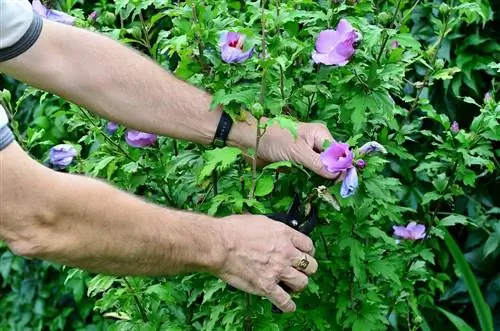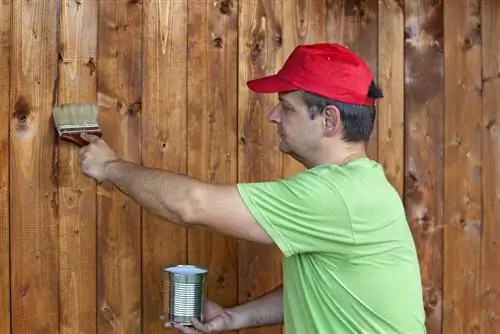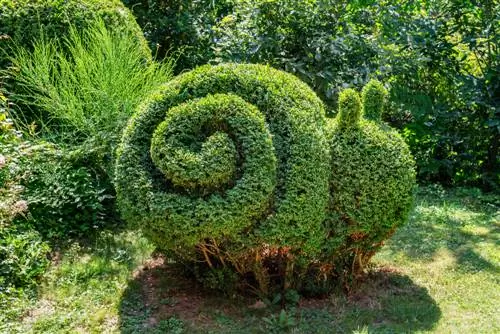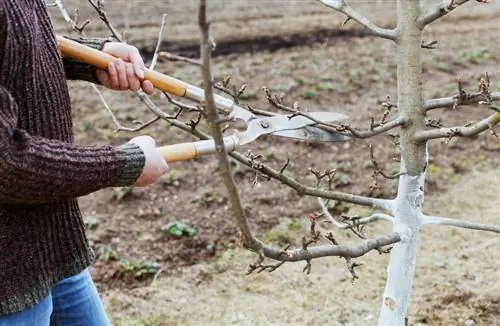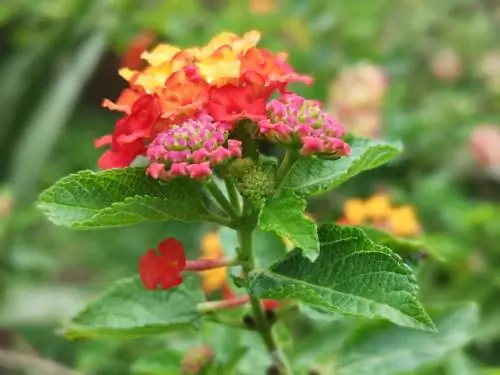- Author admin [email protected].
- Public 2023-12-26 14:17.
- Last modified 2025-06-01 06:02.
Hibiscus is an exotic flower dream with a WOW effect for beds, balconies and living rooms. The opulent ornamental shrub creates its shapely shape even without cutting. The furious flower festival only celebrates your marshmallow in glamorous perfection when you pick up the scissors once a year. This tutorial explains when and how to properly prune hibiscus in the garden and as a houseplant.
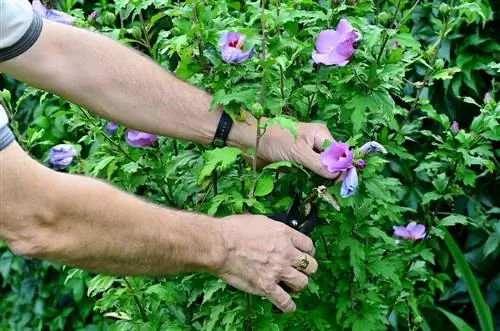
How should I cut hibiscus?
Prune the hibiscus once a year. You can grow the plant as a shrub or as a standard tree. Thin out the dead wood, shorten dead shoots and correct unfavorable scaffolding shoots. A good cut directs ground shoots that are too long onto the deeper side branches.
Why is pruning care mandatory? - Types of cuts and dates
Hibiscus species reside as opulent summer bloomers in the bed, on the balcony and behind glass. Their flowers, up to 20 centimeters in size, shine on this year's shoots, which arise from the framework-forming ground shoots. Without regular pruning, the flowering wood withers into short side shoots with few flowers, which wither exhausted within 4 weeks. With a strong pruning you pave the way for young shoots to reach the light. After all, it is this year'swoodwhere beautifulhibiscus blossoms are continually displayed from summer to late autumn.
Consequently, hibiscus becomes a picturesque permanent bloomer in beds and living rooms if you cut it professionally. The reasons for cutting range from training as a shrub or standard tree to preservation and thinning to rejuvenation. The following table briefly presents all optional cutting types with dates:
| Cut type/occasion | best date |
|---|---|
| Pruning Garden Hibiscus | after planting |
| Construction cut of shrub scaffolding | February to early March |
| Maintenance cut (outside and inside) | February to early March |
| Rejuvenation cut | November to February |
| hedge cutting | February to early March |
| Education cut high stem | End of February/beginning of March |
Pruning promotes dense branching in the garden hibiscus
Fresh from the nursery comes a young garden marshmallow with a central shoot and a few side branches. You could leave it at that and let it grow further. The scaffold structure with a solitary main shoot has proven to be disadvantageous in gardening practice. If there is damage or premature aging at the base of the bush, the entire hibiscus bush is affected. It is better if you direct the growth towards a framework of several ground shoots that support the valuable flower wood. The failure of a scaffold shoot then has no serious impact on vitality and flowering. This is how you get the perfect plant cut:
- The best time is immediately after planting
- If you purchase a flowering hibiscus, cut it the following spring
- Cut off all stunted and damaged branches in advance
- Cut back remaining shoots by half to two thirds
- Place scissors 3 or 4 millimeters above one eye
For a decorative shrub shape, it is advantageous if you leave the ground shoot in the center a little longer than the other shoots. Marsh marshmallow naturally develops a spindle-shaped silhouette with a slightly raised center. This form is easy to maintain in later years and produces a dense flower dress even when there is no time left for pruning.
Background
Growth law reveals secret of vital branching after a plant cut
Newbies to hibiscus pruning are often surprised that the shrub's reaction to the planting pruning can be predicted so reliably. In fact, the strong branching at the base of the bush results from the tried and tested growth law of top promotion. The law says that your hibiscus pumps most of its reserves into the top buds to stimulate growth towards the light. Deeper buds have to make do with significantly fewer nutrients. The further away the position from the shoot tip, the lower the sap pressure and growth. When the plant is cut, the main beneficiaries of the sap flow are simply cut off. The reserve substances are then distributed to the lower buds, which immediately sprout vigorously. The effect has a permanent effect on dense branching at the base of the bush and cannot be remedied with later types of cutting, with the exception of a rejuvenating cut.
Harmonious growth form thanks to pruning - instructions for garden marshmallow
In February of the second year, pruning care is dedicated to the further development of the scaffolding shoots. As the figure below illustrates, annual pruning aims atgrowing 5 to 7 strong ground shoots, of which 4 or 6 are centered around a slightlyraised central shootgather. The young side branches later sprout from the buds along the ground shoots, on which the longed-for flower buds form in the leaf axils. How to prune with gardening expertise:
- The best time is in February and March, in good time before budding begins
- Remove all ground shoots that do not belong to the 5 to 7 scaffold shoots
- Then cut off half or a third of theprevious year's growth on each scaffold shoot
- Leave the middle scaffold shoot 10 to 15 centimeters higher for a decorative dome shape
- Finally, cut back all side shoots along the ground shoots to 5 centimeters
The duration of the build-up phase depends on what final height you are aiming for. Due to slow growth, several years pass until a garden marshmallow has developed into a stately shrub. On the way there, you can look forward to an increasing abundance of flowers from year to year. The prerequisite is theconsistent pruningof allfaded side branches in order to encourage new shoots.
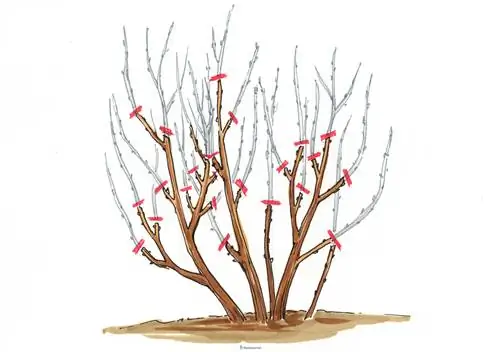
With a framework of 5 to 7 ground shoots, your garden marshmallow is well positioned for a blooming future. Ideally, 4 to 6 scaffold shoots are distributed around a higher central shoot. Valuable flowering wood emerges from the ground shoots every year.
Instructions for maintenance pruning - this is how it works outside and inside
The transition from construction to maintenance occurs when your hardy hibiscus bush in the garden has reached the desired height. Specialist retailers usually offer evergreen, frost-sensitive indoor hibiscuses with a ready-made framework. Ergo, pruning care for rose marshmallow begins with an annual maintenance pruning. The following approach has been proven to be beneficial for the conservation of all Hibiscus species outdoors and indoors:
- Best time is in February/March
- First thin out dead wood and inward-facing branches
- Remove the weaker one from two shoots that are very close together
- Cut back last year's growth on scaffolding shoots that have reached their final height
- Drop ground shoots that are too long onto a young, deeper side branch
- Finally, shorten all of the dead side branches considerably
- Cut side branches outside to 5 cm, side branches inside to 10 cm
At the time of maintenance pruning, your garden marshmallow will be leafless. Choose the cutting points 0.5 centimeters above an outward-facing bud. This exerts an impulse on the vegetation point so that it sprouts quickly. On the evergreen indoor hibiscus, the cut is made at a short distance from a leaf or leaf node. There is no need to worry if maintenance pruning leaves your garden hibiscus as a bare framework of ground shoots with short side shoots. Thanks to this cut, sap accumulates on the buds below the cut points, which allows the valuable flower wood to grow rapidly.

The maintenance cut is aimed at shape and abundance of flowers. Dead wood is thinned out, unfavorably positioned scaffold shoots are corrected and the dead shoots are shortened to short cones.
Background
Avoid gaps in the bush by cutting lines
If the cutting technique of derivation is part of the gardening repertoire, garden hibiscus and rose marshmallow maintain a harmonious, seamless silhouette after cutting. The art of special pruning is that you don't just cut off an old, unnecessary branch just anywhere. Choose afork of old and young wood as the intersection point Shortly behind this fork, cut off the worn-out branch. From now on, the young side shoot acts as a new leading shoot, without having to complain about a disturbing gap in appearance.
Successfully revitalizing hibiscus - instructions for rejuvenation cutting
An annual maintenance pruning cannot prevent one or two scaffolding shoots from aging on the older hibiscus. Garden shrubs are primarily affected because their winter hardiness decreases with age. Now you will benefit if you follow the recommendation of this tutorial to train garden marshmallow with a framework of several ground shoots. The revitalization is achieved by removing an old ground shoot and establishing a young successor in conjunction with the rejuvenation of the remaining scaffolding shoots. How to cut in an exemplary manner:
- The best time is in winter between November and February
- Saw off the old scaffolding shoot(s) down to short tenons of 5 centimeters
- Select an appropriate number of new ground shoots as replacement
- Thin out remaining competing shoots to the scaffold to 5 centimeters
- Remaining scaffold shoots lead to a vital side shoot positioned further down
As the illustration below shows, first dedicate yourself to rejuvenating the framework-forming ground shoots. In the last step, shorten the dead side branches from the previous year to 2 eyes. Thanks to this approach, a rejuvenation cut on the hibiscus does not result in the total loss of this year's flowers. Only a reduction in the number of flowers is to be expected until the young scaffold shoots have undergone a build-up, as can be found in the above part of the tutorial.
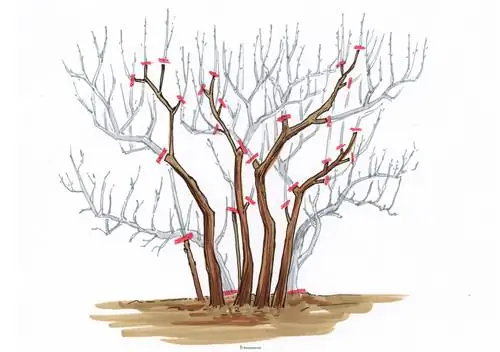
Neglected pruning care and advancing age are remedied with a radical rejuvenating pruning. Cut old ground shoots back to short cones, which dry out in summer. The remaining scaffold shoots are diverted to a deeper side shoot, which is cut back to 5 to 10 centimeters.
Excursus
The right tool for every type of cut - this is what you should pay attention to
If you have the right tools at hand, any type of cut on the hibiscus can be done effortlessly. The one-handed secateurs are suitable for pruning shoots up to a thickness of 2 centimeters, either for left- or right-handed users and as a bypass or anvil model. Two-handed pruning shears are ideal for cutting thick branches with a diameter of 2 to 4 centimeters smoothly. If you dedicate yourself to strong scaffolding shoots with a thickness of more than 4 centimeters as part of the rejuvenation, cutting with the Japanese saw or folding saw becomes child's play. There is no place for thrift when buying cutting tools. High-quality branded products won't let you down even after years. Furthermore, premium quality scissors and saws are easy to take apart for important maintenance work.
Cutting the hibiscus hedge correctly - hedge cutting instructions
With a growth height of up to 250 centimeters, hardy, pruning-tolerant garden marshmallow and its colorful varieties are ideal for picturesque flower hedges. To ensure that the shrubs provide the desired privacy factor, the maintenance cut is slightly modified.
First thin out the hedge bushes thoroughly for light-flooded and densely leafy growth. Then shorten a third of the previous year's dead shoots to 2 buds. Cut another third back by half. The last third can either be left uncut or cut at the shoot tips that protrude from the hedge shape. If necessary, a light pruning in June removes stubborn branches if they disrupt the accurate appearance.
The aim of the more moderate approach is a compromise between the abundance of flowers and the privacy function. Planting, building and rejuvenation cuts can be transferred from the solitaire to the hibiscus hedge without any changes.
Training hibiscus to be a standard tree - this is how it works in 4 steps
In the cultivation of hibiscus, training to become a standard plant is considered the supreme discipline. With the help of these instructions and a tear-proof thread of patience, you can master the challenge with flying colors. A robust, winter-hardy garden marshmallow (Hibiscus syriacus) is perfect for catching envious glances over the garden fence as an elegant standard tree in beds and pots. Choose varieties such as 'Ultramarine' or 'Hamabo', which grow faster than wild species at 15 to 30 centimeters annually. All 4 steps of parenting are explained in more detail below.
Planting pruning focuses on stem formation - first step
Education to become a standard tree begins with the planting cut. In connection with planting or in February of the following year, cut off the lateral branches of the central shoot. As the image below demonstrates, place the scissors over the second or third eye. The main stem is not cut because without its top bud it will hardly reach the desired height.
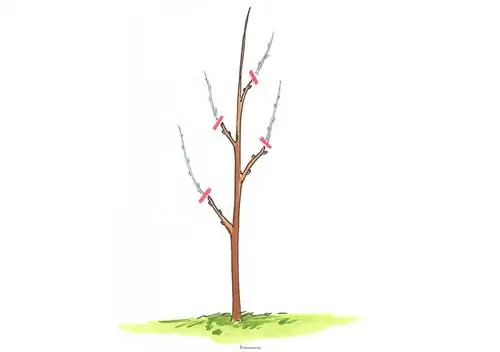
When planting, choose the strongest shoot for the future trunk. Shorten side branches to 2 or 3 eyes. Caution: Do not cut the tip of the central shoot.
Tip
You can force the formation of a stable main trunk with two further pruning measures. In the first two years of growth, cut off all branches sprouting from the trunk in May and again in July. In this way, all of the plant energy flows into the height and thickness growth of the central shoot.
One year later - second step
After completing the first year of growth, the second stage follows on the way to the elegant hibiscus standard tree. The focus is again on the lateral branches. Please take a look at the image below. You can see that the cut above the first eye is made from below.
If the future trunk has reached the desired height, you can now limit further height growth. Count three buds above the desired crown height. There you cut at a distance of 0.5 centimeters above a bud.
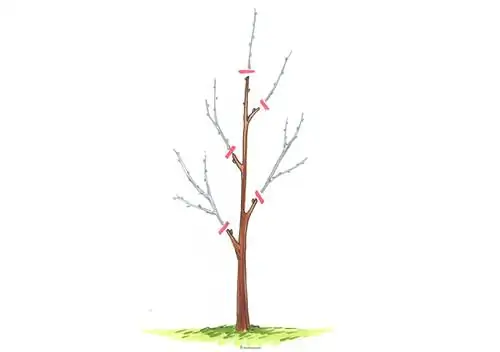
Cut off any side branches above the first eye. If the tip of the trunk is at least 3 buds above the desired crown height, place the scissors there.
Two years later - third step
At the beginning of the third year, determine the four strongest side shoots as the leading branches of the crown. Cut this off above the second or third eye. The number of eyes is counted from the base where the leading branch and trunk fork. Cut all remaining side shoots that are not part of the crown to short cones of 5 centimeters.
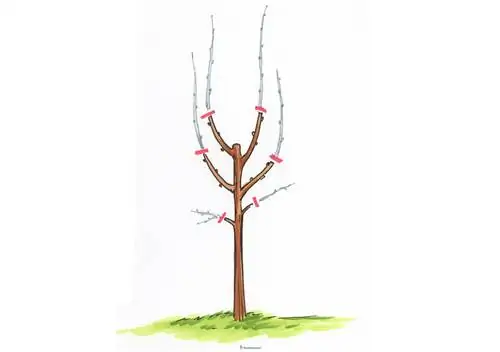
Determine three to four of the strongest side branches as leading branches. Cut these back to two or three buds in February to encourage further branching. All other side shoots must go.
Three years later - Fourth step
The third stage of education is also the beginning of the maintenance phase. Cut last year's dead shoots along the leading branches back to 2 buds. Remove branches that grow into the interior of the crown or are noticeably stunted at the base. Shorten the leading branches themselves by half within last year's growth as long as they have not yet reached the desired final length.
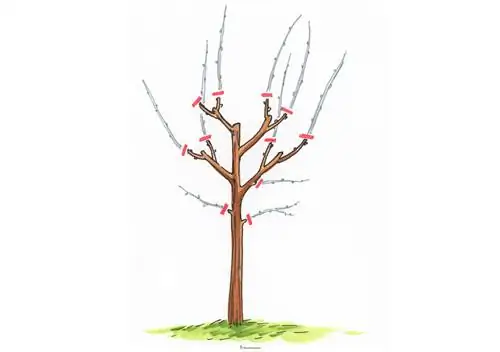
In the last step of training, cut back the previous year's flowered side branches on the leading branches to two buds. Side shoots on the trunk that do not belong to the crown are removed.
Frequently asked questions
Is hibiscus poisonous?
Hibiscus is not poisonous. The magnificent plant poses no danger to humans or animals. On the contrary, Chinese people enjoy eating its leaves, flowers and roots. The plant parts have a variety of uses in natural medicine. In Europe, the flowers are a sought-after ingredient for an aromatic and healing tea. Against this background, hibiscus is a recommended ornamental plant for the family household.
I want to transplant my 10 year old garden hibiscus. When is the right time? What should you pay attention to?
The best time to transplant is after the leaves fall. The time window remains open until the beginning/mid of March. Prick out the ball with as much root volume as possible. Important: Do not add fertilizer. A garden marshmallow is generally fertilized between the end of March and the end of July. Since the plant is older than 5 years, we recommend cutting it back by half. This measure makes it easier to root in the new location. Water a transplanted hibiscus abundantly and regularly, as drought stress is the greatest danger during growth.
Is marshmallow suitable for growing into an 80 centimeter high hedge? When will we cut?
The good pruning tolerance allows garden marshmallow to be trained as a hedge. Choose a sunny and ideally sheltered location. Pruning care is limited to maintenance and shape pruning in late winter and a light maintenance pruning in June. Pruning beyond this will noticeably affect the abundance of flowers.
I've had my hibiscus standard stem for 5 years and haven't cut it yet. In the meantime it has finally gotten a little bigger, although it is very sparsely branched. Should I cut it now?
Pruning can stimulate branching. The best time is in late winter, well before the fresh shoots. Make targeted cuts at a short distance from an outward-facing eye. The shoots then branch out below an interface. It is sufficient if you cut off the tips first because no flowers will form there. If necessary, you can cut off a little more. Then promote new growth by giving a complete fertilizer.
What is the difference between garden hibiscus and indoor hibiscus?
Garden and indoor hibiscus differ significantly in several ways. Garden hibiscus (Hibiscus syriacus) thrives as a deciduous, largely winter-hardy flowering shrub with a growth height of up to 3 meters. Its flowering period extends from June/July to September/October. Indoor hibiscus (Hibiscus rosa-sinensis), also known as Chinese hibiscus, wears its foliage all year round and reaches a height of 1 to 2 meters. The picturesque flower festival starts in February/March and lasts until October. In contrast to its counterparts in the garden, indoor hibiscus is not hardy with a minimum temperature of 10 degrees Celsius.
My hibiscus bushes are spreading throughout the garden with countless seedlings. What can I do about it?
Hibiscus bushes tend to spread invasively in light soils and mild regions. The conquest through the garden takes place with the help of myriad seeds, which transform into strong seedlings in no time. Such a propagation strategy can become annoying in the long run. Continuously cutting out the seed pods during the flowering period is very laborious. It is better if you remove all the seed heads from bottom to top with your hand in the fall. Hold a bowl underneath with your other hand to catch the seed pods. Please dispose of the capsules in the trash can because they are guaranteed to find their way into the garden from the compost.
The 3 most common cutting mistakes
| Cutting errors | malicious image | Prevention |
|---|---|---|
| cut in autumn | Frost damage up to total failure | Cutting hibiscus in February |
| never cut | few flowers, short flowering period | prune vigorously every year in late winter |
| Middle shoot on the tall stem cut off too early | puny-little tall stem | First cut off the tip bud 3 buds above the desired crown height |
Infestation with diseases and pests on Hibiscus species is closely related to improper pruning care. Themost common causefor infection with pathogenic pathogens areunclean cutting tools Before starting, during and at the end of cutting work, you should disinfect the blades or saw blades with alcohol. Thanks to this caution, aphids, mildew spores and the like can no longer abuse the tools as a welcome means of transport to their floral victims.

Tip
If winter leaves a garden marshmallow as a lifeless bush, it is usually not due to frost damage. Constant winter wetness takes a massive toll on the roots in the soil. You can effectively prevent damage by covering the root disc with leaves and coniferous twigs or a thick layer of bark mulch. Frozen shoots are subjected to regular maintenance pruning without affecting this year's flowering.

